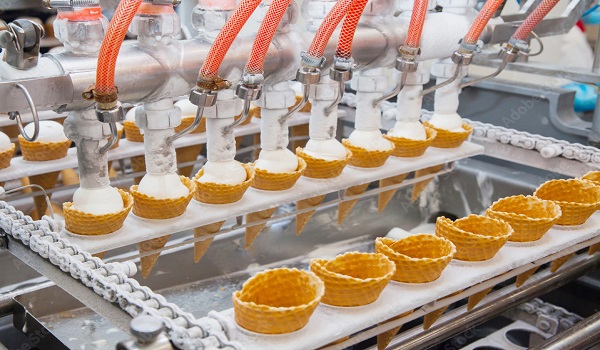There have been several technological updates in ice cream processing technologies that have improved the efficiency and quality of ice cream production. The Indian ice cream industry is in transition. Corrections in processing for hassle-free production can be vital for mid- and small-sized companies. Some of these updates from the global arena are given below:
Continuous Freezers:
Continuous freezers are used in ice cream production to freeze and mix the ice cream ingredients in a continuous process. Here is how they work:
Mixing:
The ice cream mix is prepared by combining ingredients such as milk, cream, sugar, and flavours. The mix is then heated to pasteurize it and homogenized to ensure a consistent texture.
Feeding:
The mix is fed into the continuous freezer through a feed pipe.
Freezing:
The mix is then frozen by passing it through a rotating drum or cylinder that is cooled by refrigerant. The drum has a scraper blade that scrapes the frozen mix from the walls of the drum.
Air Incorporation:
As the mix freezes, air is incorporated into it to give the ice cream its light, fluffy texture. This is done by injecting air or another gas into the mix before or during freezing.
Mixing:
The frozen mix is mixed and blended by the scraper blade as it is scraped from the drum. This ensures that the ice cream is uniform in texture and flavour.
Discharge:
The finished ice cream is discharged from the freezer at a controlled rate and temperature, and then packaged or stored. Continuous freezers offer several advantages over traditional batch freezers. They can produce ice cream at a faster rate, and the ice cream they produce is more consistent in texture and quality. Additionally, continuous freezers require less labour and energy than batch freezers, making them more cost-effective for large-scale ice cream production.
High-pressure homogenization:
High-pressure homogenization is a process used in ice cream processing to break down the fat globules in the ice cream mix and create a smoother, creamier texture.
Here is how it works:
The ice cream mix is then pumped through a homogenizer machine, which uses high pressure to force the mix through a small nozzle or series of nozzles. This breaks down the fat globules in the mix into smaller particles, typically less than 1 micron in size.
Shearing:
As the mix is forced through the nozzle, it undergoes a process known as shearing, where the mix issubjected to high levels of mechanical stress. This further breaks down the fat globules and helps to create a smooth, creamy texture
Cooling:
After homogenization, the ice cream mix is cooled and aged for several hours or overnight to allow the flavours to develop.
Freezing:
The ice cream mix is then frozen using a continuous freezer, which incorporates air into the mix to give it its light, fluffy texture.
High-pressure homogenization offers several advantages over traditional homogenization methods. It also reduces the size of ice crystals in the ice cream, which helps prevent it from becoming icy or grainy.
Additionally, high-pressure homogenization can increase the shelf life of ice cream by reducing the growth of bacteria and improving the stability of the mix.
Preparation of ingredients:
The ingredients, such as milk, cream, sugar, and flavours, are added to the mixing tank.
Automated mixing:
The mixing tank is equipped with an automated mixing system that ensures the ingredients are mixed thoroughly and consistently. The mixing system can be programmed to mix the ingredients for a specific amount of time and at a specific speed.
Temperature control:
The mixing tank is also equipped with a temperature control system that ensures the ingredients are mixed at the correct temperature. This system can be programmed to maintain the desired temperature throughout the mixing process.
Automated blending:
After the ingredients are mixed, the mix is then transferred to a blending tank. The blending tank is equipped with an automated blending system that ensures the mix is blended thoroughly and consistently.
Quality control:
During the mixing and blending process, samples of the mix are taken and analyzed to ensure that themix meets the desired specifications in terms of taste, texture, and consistency. Automated mixing and blending systems offer several advantages over traditional mixing and blending methods.
They ensure that the ingredients are mixed and blended thoroughly and consistently, resulting in a more uniform product. They also reduce the amount of labour required for ice cream production and improve efficiency.

Computerized control systems:
Computerized control systems can be used in ice cream manufacturing to automate and optimize various processes, including mixing, homogenization, pasteurization, and freezing. In a typical ice cream manufacturing process, the first step is to mix the ingredients, which typically include milk, cream, sugar, and various flavours and additives.
A computerized control system can be used to precisely control the amount of each ingredient added, as well as the mixing speed and duration, to ensure consistent quality and flavour.
After mixing, the ice cream base is typically pasteurized to ensure that any harmful bacteria are eliminated. Again, a computerized control system can be used to precisely control the temperature and duration of the pasteurization process.
It is typically homogenized to ensure that the fat particles are evenly distributed. A computerized control system can be used to control the pressure and duration of the homogenization process, which can impact the texture and consistency of the final product.
Finally, the ice cream is frozen, typically using a continuous freezer. A computerized control system can be used to precisely control the temperature and speed of the freezer, as well as the air content and viscosity of the ice cream, to ensure that the final product has the desired texture and consistency.
Throughout the entire ice cream manufacturing process, a computerized control system can monitor and adjust various parameters, such as temperature, pressure, and mixing speed, to ensure that the process is running optimally and that the final product meets the desired quality standards.


